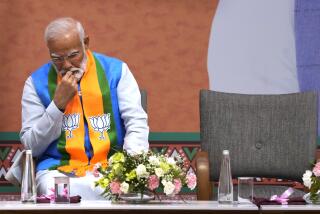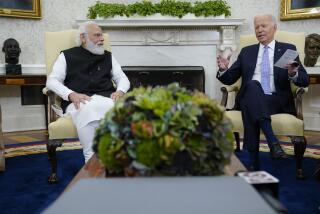Indian Economy’s Reform Engine Stalls
- Share via
NEW DELHI — At a recent economic conference here, one of India’s more self-confident politicians was touting the country’s bright business prospects to a group of foreigners when the electricity in the room failed.
Talking straight through the blackout, Parliament member Rajesh Pilot told the participants, “We are very hopeful.”
Power failures at five-star hotels are among this country’s least pressing economic problems, but the incident at the Taj Palace earlier this month underscored India’s halting march to economic liberalization, which affects everything from the price of rice in the most remote village to the flow of electricity in the nation’s capital.
Six years after this nation of 950 million embarked on a monumental effort to dismantle its socialist economy, the process has entered an uncertain time. The economy, after several years of impressive growth, has begun to slow. Relics of the Soviet-style system survive intact.
The slowdown in the Indian economy has coincided with the tailspin of the economies of East Asia. Although economists say India’s current troubles are largely home-grown, they say dithering by the country’s leaders could ensure that India misses an opportunity to set itself apart from the rest of Asia.
“With the crisis in Southeast Asia, Western investors will be looking to India,” said Gerald Segal of the International Institute for Strategic Studies in London. “But one senses there is a window that is about to be missed.”
With the country’s political leaders locked in paralyzing, petty quarrels, many business operators in India say they fear the country is stalling just as it should be finishing the job of liberalization.
“It’s very frustrating,” said Sanjeev Nanavati, an investment banker for Standard Chartered Bank in Bombay. “Investors see a situation like this and they don’t know what is going to happen next.”
The catalyst for the malaise is the recent collapse of the Indian government. The 7-month-old government of Prime Minister Inder Kumar Gujral fell last month after a minor dispute prompted the Congress-I Party, which has governed the country for most of the 50 years since independence, to withdraw its support.
The fall of Gujral’s government, India’s fourth in two years, cleared the way for nationwide elections early next year and shelved an array of reform measures whose passage had been eagerly awaited by foreign investors.
The Gujral government’s demise came as the Indian economy, which only two years ago was growing at a 7% rate, began to run out of steam. Economists predict that this year the Indian economy may grow by little more than 5%, and maybe less. The benchmark index of the Bombay Stock Exchange has dropped around 20% since the spring. Moody’s Investors Service recently downgraded Indian bonds to the lowest investment grade.
The crisis guaranteed India several more months of political instability, which analysts say has already forced a succession of weak governments to shy away from offending the special interests blocking further reform.
The effort to dismantle the country’s centrally planned economy got underway in 1991, when an economic crisis forced the country to the brink of collapse. Governments since have removed restrictions on foreign investment, cut tariffs and tossed out price controls.
*
The results have been impressive. With the U.S. leading the way, direct foreign investment has poured into the country and this year could top $3 billion--the most ever in a single year. In six years, exports have doubled. Not only has India’s economy grown at a robust pace, it has avoided the traumatic adjustments suffered in some of the Eastern European countries. The newly rich now flaunt their wealth in every large Indian city.
“The process of reform is irreversible,” Gujral told a group of business people in a speech earlier this month.
Fifty years ago, billboards bearing the slogan “Be Indian--Buy Indian” rang with the same idealism that inspired Mohandas K. Gandhi in his fight to end British colonial rule. India’s centuries-old caste system and its millions of poor seemed to confirm the need for economics that redistributed the wealth.
As Gujral said, “We are not simply changing policies--economic reform means bringing in a new culture.”
Those trying to push through reforms ask for patience when confronted by business people complaining that they are moving too slowly. The politicians point to the size of the Indian nation, its 500 million voters, 21 major languages, 50,000 trade unions and 530 political parties.
Many Indian business people are running out of patience. A growing number complain that it is not India’s varied electorate that is hampering reform--it is the politicians in New Delhi themselves.
“This corrupt, polluted city, its resident leaders and bureaucrats, today hold the destiny of the entire nation hostage to their greed, their ignorance of everything outside the sphere of their self-interest, and their lack of vision,” columnist K.P.S. Gill wrote recently for the Pioneer, one of the country’s largest newspapers.
Business people eager to compete in the international economy say they need the government to complete the process of reform--and then get out of the way. They refer derisively to the “Steel Frame,” the corrupt, elephantine bureaucracy that demands bribes but still can’t perform.
Naushad Forbes, a Bombay businessman who manufactures components for steam engines, says low-level bureaucrats routinely hit him up for bribes--at the threat of holding up shipments. And still, he says, once he sends out his products for export, it takes two weeks for them to actually leave the country. They are held up, he says, by innumerable checks and inspections.
Worse yet for frustrated business people, there is no guarantee that the economic reforms will continue even after next year’s elections, scheduled for February and March. The Hindu nationalist Bharatiya Janata Party, which many here predict to win the nationwide elections, promises to allow foreign investors to help develop roads and power plants and high-tech projects.
But the BJP may keep out foreign companies that want to sell consumer goods such as toothpaste, junk food and stereos. The BJP slogan: “Microchips, not potato chips.”
“Why do you need McDonald’s when we already have snacks?” asked BJP General Secretary Sushma Swaraj as she served a bowl of roasted peanuts to a recent visitor.
The BJP has drawn the support of one group of business people, known as the Bombay Club, who feel threatened by foreign competition. One of them is Rahul Bajaj, whose company, Bajaj Auto, makes auto rickshaws and scooters.
“Nobody welcomes competition,” Bajaj said.
The most likely outcome of the upcoming elections, analysts say, is a coalition government with no majority in Parliament. Such a government probably would not enact the unpopular measures needed to kick-start India’s economic reform: firing public employees, deregulating the financial sector and eliminating the subsidies that consume nearly 15% of India’s GDP.
Recently, both the national and state governments seemed incapable of decisive action. When public employees went on strike, Gujral gave 5 million of them a raise and raised taxes to pay for it. When the government in Haryana state tried to reduce the subsidy for electricity, angry farmers blocked the roads and burned railway stations, and the state government reversed ground.
“I don’t expect to see any major push for reform out of the next government,” said Saugata Bhattacharya, an analyst for the Investment Research and Information Service in New Delhi.
*
Despite the uncertainty, some analysts remain optimistic about India’s future. Even with the slowdown, most economists are predicting moderate growth over the next year. Compared to the rest of Asia, where many economies are contracting, that’s likely to attract attention.
Stephen R. du Mont, a business consultant based in Utah, says he gave up on India a decade ago. Today, he’s back, and he says approvals he once waited years for now take weeks.
“This country has come a long way,” Du Mont said.
(BEGIN TEXT OF INFOBOX / INFOGRAPHIC)
India Indicators
Gross domestic Product
Annual percentage change
1997-98*: 5.5% (Projected)
(Please see newspaper for full chart information)
India Indicators
Sensex 30 Stock Index Friday close: 3633.38
(Please see newspaper for full chart information)
Source: Monthly Review of Indian Economy, Centre for Monitoring Indian Economy, Mumbai
More to Read
Sign up for Essential California
The most important California stories and recommendations in your inbox every morning.
You may occasionally receive promotional content from the Los Angeles Times.













